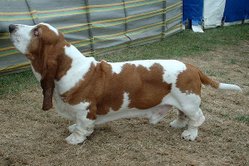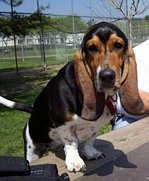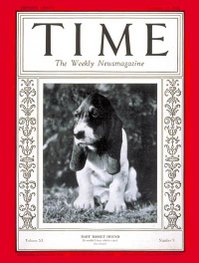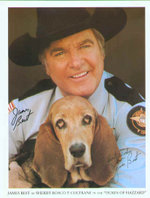Basset Hound
Dogs
Basset Hound
| Basset Hound |

Red and white Basset
|
| Alternative names |
| |
| Country of origin |
|
France |
| Common nicknames |
| |
| Classification and breed standards |
|
FCI: |
Group 6 Section 1 #163 |
|
|
AKC: |
Hound |
|
|
ANKC: |
Group 4 (Hounds) |
|
|
CKC: |
Group 2 - Hounds |
|
|
KC (UK): |
Hound |
|
|
NZKC: |
Hounds |
|
|
UKC: |
Scenthound Breeds |
|
| Not recognized by any major kennel club |
| This breed of dog is
extinct |
| Notes |
| |
The Basset Hound is a chunky, short-legged
breed of
dog of the
hound family.
They are
scent hounds, bred to hunt by scent. Their sense of smell for tracking is
second only to that of the
Bloodhound.
The name Basset derives from the French word "bas" meaning "low" or "dwarf".
Appearance
These dogs are around 33 to 38 cm (13 to 15 inches) in height at the
withers. They
have smooth, short-haired coats and are generally
tricolor
(black, tan, and white). These dogs also occur in open red and white (red spots
on white fur), closed red and white (a solid red color with white feet and
tails), and lemon and white. Some, though few, are also classified as grey
Basset Hounds.
They have long, low-set
ears and powerful
necks, with much
loose skin around their heads that forms wrinkles. Their
tails are long and
tapering and stand upright with a curve. The breed is also known for its hanging
skin structure,
which causes the face to have a permanently sad look; this, for many people,
adds to the breed's charm. The loose, elastic skin around the neck and trailing
ears are thought to help catch the scent of what they are
tracking.
Basset Hounds are a "large dog" on short legs. They were specifically bred to
have dwarfism,
specifically
achondroplasia. Their short stature can be deceiving: Bassets are
surprisingly long and can reach things on table tops that dogs of similar
heights cannot.
Temperament
 Tricolour Basset
Tricolour Basset
The Basset Hound is a very calm and companionable breed, but they are often
very stubborn. They are an especially loyal breed, are very friendly, and will
gladly play with children. Bassets are amiable and generally love being around
people.
When left on their own, Bassets tend to excessively eat and sleep rather than
exercise. Care must be taken to prevent unhealthy
weight
gain. The mournful appearance of the Basset Hound can cause owners to be
"sympathetic" and give them extra food; owners should resist this temptation
lest their dogs become
overweight.
Like other hounds, Basset Hounds are often very difficult to
obedience train. Many Basset Hounds will obey commands when offered a food
reward, but will "forget" the training when a reward is not present. Bassets are
notoriously difficult to
housebreak.
The breed has a strong hunting instinct and will give chase or follow a scent
if given the opportunity. They should be trained in
recall;
failing that, they should be kept on a
leash when out on
walks.
Bassets might howl or bay rather than bark when they want something or to
suggest that they think something is wrong.
History
Basset Hounds are an aristocratic breed of
French lineage,
a descendant of the St. Hubert's Hound, a dog similar to the present-day
Bloodhound. Friars of St. Hubert's Abbey in
medieval
France desired
a shorter-legged dog, capable of following a scent under brush in thick forests,
as hunting was a classic sport of the time. Both Bassets and St. Hubert's Hounds
were bred to trail, not kill, their game. Bassets were originally used to hunt
rabbits and
hare. The first
application of the word "Basset" to a breed of dog can be traced to an
illustrated text on hunting written by
Fouilloux in 1585.
Early French Bassets closely resembled the
Basset Artésien Normand, which is still a breed today though it is not
recognized outside of France. Because many short-legged dogs from this time were
called basset and record-keeping from this time was sparse, it is
difficult to speculate which of these breeds have bloodlines in common with
today's Basset Hounds. It is commonly believed that
Marquis de Lafayette brought Basset Hounds to the
United States as a gift to
George Washington.
In 1863 the
Basset Hound reached international fame at the Paris Dog Show. At that time
there were two common Bassets, those with a rough coat (Basset Griffon)
and those with smooth (Basset Français). The dogs were further classified
by the length of their legs. The two popular Basset breeders at this time were
M. Lane and the Count Le Couteulx.
In 1866, Lord
Galway imported a pair of Le Couteulx Bassets to
England, but
it was not until 1874
that Basset Hounds were widely introduced there by Sir Everett Millais.
The Kennel Club accepted the breed in
1882 and the
English Basset Hound Club was formed in
1884. The
American Kennel Club first recognized Basset Hounds as a breed in
1885. In
1935, the Basset
Hound Club of America was organized in the United States. The current American
breed standard was adopted in
1964.
Health
In comparison to other breeds, the Basset Hound is an especially healthy
breed, but there are some illnesses to which they may fall prey.
They are a deep-chested breed, and are therefore prone to
bloat. Many
bloodlines are genetically prone to
glaucoma,
luxating patella, and
ectropion
("cherry
eye"). Young Bassets occasionally develop
panosteitis. Older Bassets occasionally develop
Von Willebrand disease. Long dogs on short legs can easily develop
back pain,
especially if excessive weight is already a concern.
Hip
dysplasia can be a problem in Bassets. Grey Basset Hounds are more likely to
be born with medical problems, and it is advisable not to purchase these.
Care
Bassets tend to shed a lot, but do not require frequent brushing. Like the
Bloodhound,
they are a "wet mouthed" dog and tend to drool. As Basset Hounds often overeat,
feedings should be regulated to prevent weight gain. Long ears are prone to
infection if not regularly cleaned. Trailing
bellies and
massive paws will
carry and track dirt to the despair of many owners.
Miscellaneous

In 1928,
Time magazine featured a Basset Hound on the front cover. The
accompanying story was about the 52nd annual
Westminster Kennel Club Dog Show at
Madison Square Garden as if observed by the Basset Hound puppy. This
prestige is often seen as the event which made the Basset Hound a popular part
of American
pop culture.
Famous Bassets
Basset Hounds have had prominent roles in
movies and
television.
Cartoon characters
- The cartoon character
Droopy
Dog, originally created in 1943 by Tex Avery
- Fred Basset, the main character in the comic strip
Fred
Basset, created by Alex Graham in 1963
 Sheriff Rosco P. Coltrane and sidekick, "Flash" from The Dukes of Hazzard
Sheriff Rosco P. Coltrane and sidekick, "Flash" from The Dukes of Hazzard
Films and TV
- Cleo, in
Jackie Cooper's 1950s TV show
The People's Choice
- The Basset Hound simply called "Dog" from 1970s TV series
Columbo
- Fred, the companion of Cledus in the 1977 movie
Smokey and the Bandit
- Flash, the dog owned by
Sheriff Rosco P. Coltrane in the 1980s TV series
The Dukes of Hazzard
- Quincey, owned by Luther in the 1990s sitcom
Coach
- Sammy from the TV series
That's So Raven
In advertising
- The logo
for
Hush Puppies brand shoes; Basset Hounds are occasionally referred to as
"Hush Puppies" for that reason
- A Basset Hound is the companion to the lonely Maytag Man in
Maytag appliance
advertisements
External links
Home | Up | Bandog | Barbet | Basenji | Basset Fauve de Bretagne | Basset Hound | Bavarian Mountain Hound | Beagle | Bearded Collie | Beauceron | Bedlington Terrier | Belgian Shepherd Dog | Belgian Shepherd Dog (Groenendael) | Belgian Shepherd Dog (Laekenois) | Belgian Shepherd Dog (Malinois) | Belgian Shepherd Dog (Tervueren) | Bergamasco | Berger Blanc Suisse | Bernese Mountain Dog | Bichon Frisé | Biewer | Black Russian Terrier | Black and Tan Coonhound | Bloodhound | Bluetick Coonhound | Boerboel | Border Collie | Border Terrier | Borderjack | Borzoi | Bosnian Tornjak | Boston Terrier | Bouvier des Flandres | Boxer | Boykin Spaniel | Brazilian Terrier | Briard | Brittany | Bull Terrier | Bull Terrier (Miniature) | Bull and Terrier | Bulldog | Bullmastiff | Bully Kutta
Dogs, made by MultiMedia | Free content and software
This guide is licensed under the GNU
Free Documentation License. It uses material from the Wikipedia.
|




